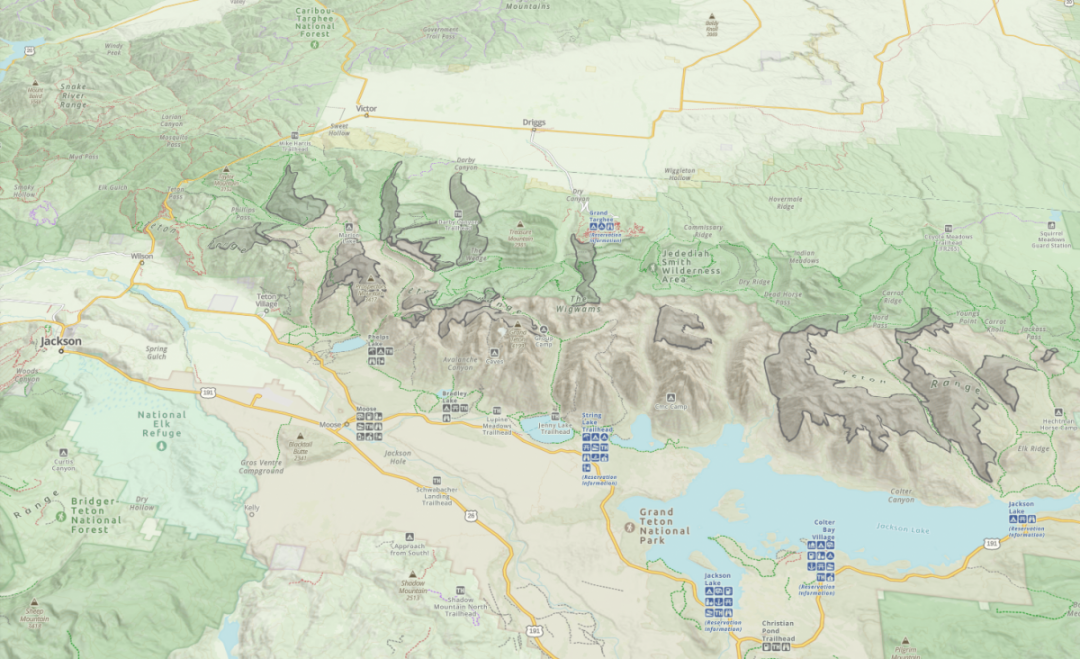Last fall, as WildSnow began ramping up coverage of the 2021-2022 ski season, we reported on land use issues involving Teton Range bighorn sheep populations and backcountry skiers/riders. For several years, wildlife biologists and officials documented a decline in endemic bighorn sheep. One cause of the decrease in numbers, according to researchers, was disturbances due to winter backcountry users, primarily backcountry skiers and riders.
The short and potentially long-term solution is to restrict winter recreation in critical bighorn sheep habitat in and around Grand Teton National Park (GTNP). So far, the Teton Sheep Working Group has been responsible for developing policy recommendations. The working group includes members from the surrounding National Forests, GTNP, Wyoming Game and Fish Department, and two non-profits. During a widely viewed public forum last October, a moderator intimated the Working Group might eventually include a member of the outdoor recreation community. According to the Working Group’s website, the membership of the six-member group remains unchanged.

A Gaia Gps screenshot of the georeferenced map released on Jan. 14. The map’s gray zones detail zones where voluntary avoidance is requested. Currently, the summits of Mount Hunt/Prospectors Mountain and Static Peak are closed from Dec. 1 through April 30.
GTNP published a press release titled “Working Group asks skiers to avoid Teton Range Bighorn Sheep Winter Zones” in mid-January. The document asked winter recreationists to voluntarily avoid specific demarcated zones to protect sheep. Before the January 14th announcement, GTNP and the adjacent National Forests had not officially asked for voluntary avoidance. The ask for voluntary compliance by the Working Group made some of the management ideas put forth last fall to protect bighorn sheep actionable.
Along with the January announcement, maps were published detailing the locations of the voluntary and already-closed portions of the sheeps’ habitat.
Again, if you are new to this issue, digging into last fall’s coverage is worthwhile; the problems are complex and have evolved over several years. WildSnow also published four Op-Eds from winter backcountry users on the topic.
Op-Ed 1, Op-Ed 2, Op-Ed 3, and Op-Ed 4.
The current voluntary and required closures are seasonal, most closures expire at the end of this month. Next winter, more concrete recommendations for limiting user access to winter bighorn sheep habitat are expected, with many positing the voluntary closures will become mandatory.
Last week, GTNP officially began the process of establishing new bighorn sheep guidelines by releasing a scoping notice. This notice presents the GTNP’s intentions and allows stakeholders a specific timeframe to comment on those proposed changes. The comment period, in this case, closes on May 20.
According to the notice, GTNP is considering the following mitigation: “increased public outreach and education; new signage and map products; enhanced monitoring of both bighorn sheep populations and winter recreation use; new or expanded winter habitat protection areas for bighorn sheep; areas where recreational access is maintained; and designated travel routes through some bighorn sheep winter habitat zones. Specifically, the bighorn sheep voluntary avoidance areas or bighorn sheep winter habitat zones (see map on the following page) that were in effect in winter 2021/2022, would be evaluated for seasonal access restrictions from December 1 – April 30. In addition, the NPS will further analyze the recommended Avalanche Canyon winter habitat zone, which was not part of the voluntary avoidance areas this past winter.”
In response to the scoping notice and the call for comments, several recreation-based non-profits, which include the Teton Backcountry Alliance, Teton Climbers’ Coalition, Winter Wildlands Alliance, American Alpine Club, and Access Fund, developed an anonymous survey to collect information. These advocacy groups plan on submitting their survey findings to the National Park Service, Forest Service, and Wyoming Fish and Game to inform the decision-making process.
The Jackson Hole News and Guide reports these stakeholders have submitted a formal letter to GTNP asking for an extension of the comment period until June 19.
Those interested in commenting can do so online or in writing with a letter addressed to:
Grand Teton National Park Planning Office
Attn: Bighorn Sheep Winter Habitat Protection
P.O. Box 170
Moose, WY 83012-0170

A slide from the working group’s October presentation showing that the majority of the sheep’s winter range would be protected.
One last relevant item was reported by Buckrail, a community-based news site in Jackson Hole. The story noted biologist has used different methods to assess the bighorn sheep population; it is likely the overall population is higher than previously thought. In the past, researchers relied on helicopters to estimate herd numbers. A new study halfway through its four-year duration uses more accurate analyses using DNA from scat. Recent estimates using helicopters had pegged the population at roughly 100 animals. According to Buckrail’s reporting, that number might be as high as 178 summertime bighorn sheep. Even with the possibly higher number of sheep, a GTNP biologist contacted by Buckrail stated the sheep still required protections to remain viable.
Jason Albert comes to WildSnow from Bend, Oregon. After growing up on the East Coast, he migrated from Montana to Colorado and settled in Oregon. Simple pleasures are quiet and long days touring. His gray hair might stem from his first Grand Traverse in 2000 when rented leather boots and 210cm skis were not the speed weapons he had hoped for. Jason survived the transition from free-heel kool-aid drinker to faster and lighter (think AT), and safer, are better.
